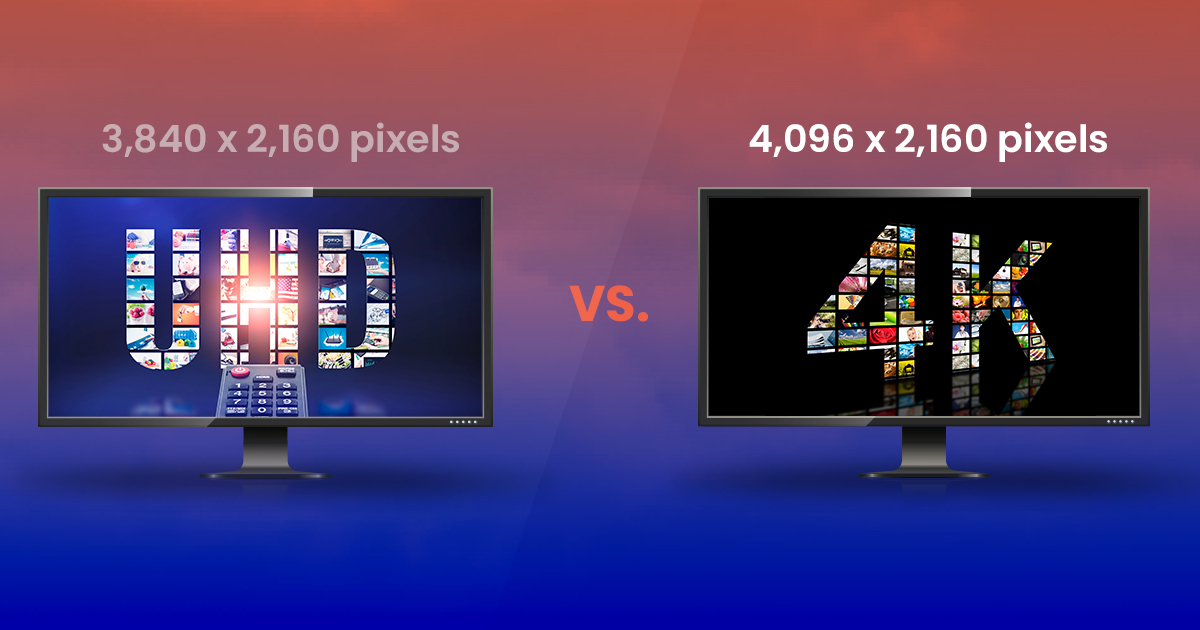When was the last time you saw an electronic store display the gamut of its 'UHD 4K TV' in various sizes? We bet, not long ago. The terms UHD (Ultra High Definition) and 4K are often used interchangeably not just by TV or monitor manufacturers and sellers also by broadcasters. Though the lines between the two seem blurry, there are considerable differences. In this blog, we’re going to explore how UHD is different from 4K.
- Resolution and aspect ratio
Since its inception in 1979 by the Japan Broadcasting Corporation, HD TV (high definition television) has come a long way. Modern-day HD displays have a resolution of 1280 x 720 pixels. Full HD (FHD) offers 1920 x 1080 pixels resolution. UHD offers 3,840 x 2,160 pixels, four times that of FHD, bringing life-like pictures to your TV screens. With precisely 8,294,400 pixels, the UHD display is way richer and offers an immersive experience.
Another differentiator is the aspect ratio – the ratio between a display's width and height. The aspect ratio for UHD is 1.78:1 or 16:9. This is the most compatible aspect ratio for TVs and monitors and can host videos of any aspect ratio without distorting the displayed image.
4K, on the other hand, offers a resolution of 4,096 x 2,160 pixels, slightly more than UHD. This translates to more refined details and textures. Since the horizontal pixel count is slightly over 4,000, it gets the name 4K, with K signifying kilo (or ‘a thousand’ in Greek). The aspect ratio for 4K is 1.9:1 or 16:9, popularly known as the IMAX aspect ratio. It allows for a more vivid and theater-like experience on a TV screen.
- Standards
UHD is a consumer display and broadcast standard which includes desktops, televisions, and video walls. 4K is a professional production and cinema standard where projectors play a crucial role. 4K can cater to both Flat aspect ratio (1.85:1) with a resolution of 3996 x 2160, and to Scope aspect ratio (2.39:1) with a resolution of 4096 x 1716. Flat and Scope help accommodate content with incompatible aspect ratios by adding horizontal black bars called letterboxes, or vertical black bars called pillar boxes around the image. These bars help fit an image to the screen without truncating it.
- Content Availability
Most of the content produced today is in UHD format. With most TVs in the market being UHD, watching UHD content on a UHD TV gives an unparalleled viewing experience.
4K TVs and monitors, though readily available in the market, are pricier than UHD TVs. 4K TVs provide you with access to 4K content upon subscribing to one of the many available streaming services. Streaming devices like Amazon Fire TV Stick, Apple TV 4K – fifth generation and above, and Roku Streaming Stick+ also enable access to 4K content.
Compared to UHD, the availability of 4K content is not as prominent. For example, Netflix requires you to subscribe to a premium plan to access its 4K content. Hulu's standard service offers a limited library of 4K content and costs $7/month, or $70/year, after a 30-day free trial.
Two other parameters contributing to a better viewing experience on a 4K TV are upscaling and refresh rate.
- Upscaling: Upscaling is optimizing low-resolution content on a 4K TV to fit its display panel and offer a sharper viewing experience. By optimizing, we mean enhancing the image to improve the contrast and color without adding any extra elements. Upscaling doesn't convert the content to 4K; it simply makes the content look less pixelated on the screen. Devices like 4K Blu-ray players also help achieve upscaling without requiring hefty investments on a 4K TV.
- Refresh rate: Another aspect that sets 4K apart is the high refresh rate. Refresh rate (measured in Hertz, Hz) is the number of times per second a TV can 'draw' or refresh an image on its screen. Most 4K TVs offer a refresh rate of 60Hz, with a few higher-end models offering 120Hz. This means that every second, 60 or 120 frames are updated on the screen based on the refresh rate. To the human eye, the series of frames makes way for a smoother, immersive experience, especially when watching live sports or high-action movie sequences.
4K TV: To buy or not to buy?
According to Statista, the prices for 4K TVs have dropped significantly over the past few years, thus reaching mainstream adoption. For instance, in 2022, around 30% of Americans aged between 18 and 34 years old owned a 4K TV set. This transition from standard to high-end household devices is worth mentioning, showing an upward trajectory in 4K TV sales.
The decision to buy a 4K TV depends on your priorities. If you are a movie aficionado and do not want to compromise for anything less than a cinema-like feel on your TV, 4K is your best bet. Additionally, if you edit photographs, are a professional cinematographer, or a gamer, 4K delivers the crisp vision you’d want. However, this life-like picture quality comes at a price – the higher cost of 4K TVs or Blu-ray devices, subscription cost of 4K streaming apps, and high-speed internet of at least 15 Mbps are basic requirements.
Buying a UHD TV is a no-brainer and the most economical choice if you watch movies for pure entertainment.
While the debate between UHD and 4K is thought-provoking, 8K is on the brink of becoming the new 4K, with manufacturers working toward competitive pricing.
Learn how to create, distribute, and monetize your UHD and 4K content with Amagi. Write to us at cloudandme@amagi.com.





